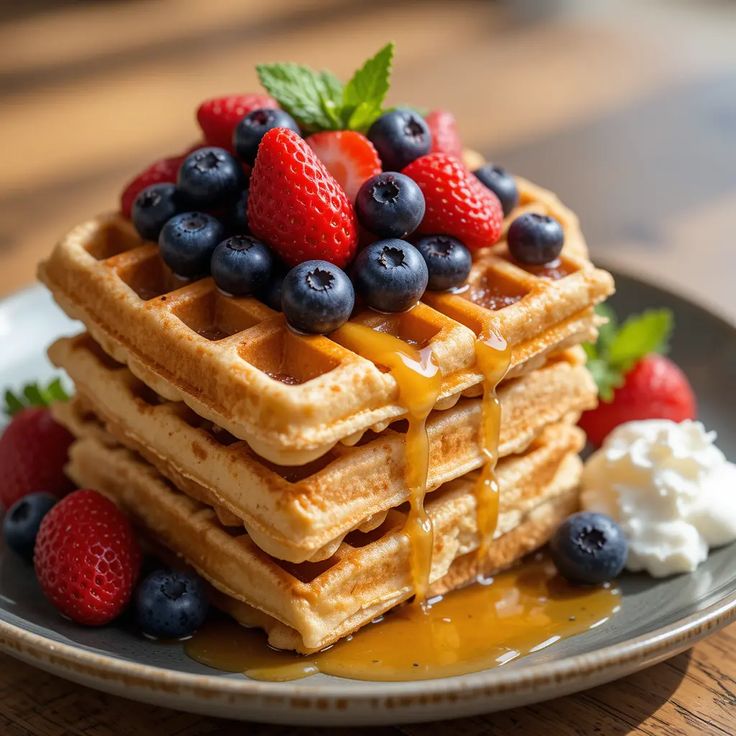Waffles are more than just a weekend breakfast favorite — they’re a beloved global dish with centuries of history, endless variations, and a reputation for comfort and indulgence. Whether you’re craving a classic Belgian waffle topped with syrup or experimenting with savory stuffed varieties, this in-depth guide has everything you need to become a waffle master.

Table of Contents
- Introduction to Waffles
- A Brief History of Waffles
- Essential Ingredients and Equipment
- Classic Waffle Recipe
- Waffle Variations
- Troubleshooting Common Waffle Issues
- Toppings and Syrups
- Global Waffle Styles
- Dietary Alternatives
- Storage and Reheating
- Waffle FAQs
- Final Thoughts
1. Introduction to Waffles
Waffles have earned a permanent place on breakfast tables across the world. Their crispy edges, fluffy centers, and deep grid pattern make them perfect for soaking up butter, syrup, fruit, and other toppings. But beyond their delicious taste, waffles are a testament to how simple ingredients can be transformed into something extraordinary.
2. A Brief History of Waffles
Waffles trace their origins back to Ancient Greece, where flat cakes called “obelios” were cooked between hot metal plates. The modern version began taking shape in the Middle Ages, particularly in Belgium and the Netherlands. By the 18th century, waffles had spread across Europe and into North America, where they became a culinary staple.
Belgian waffles rose to fame in the U.S. during the 1964 World’s Fair in New York. Since then, the waffle has evolved into countless regional and modern styles — both sweet and savory.
3. Essential Ingredients and Equipment
Basic Ingredients:
- Flour: All-purpose flour works well, but pastry flour yields lighter waffles.
- Eggs: Separate and whip the egg whites for extra fluffy waffles.
- Milk or Buttermilk: Buttermilk adds tang and tenderness.
- Butter or Oil: Adds richness and helps with browning.
- Sugar: For sweetness and crisp edges.
- Baking Powder/Soda: Provides lift and fluffiness.
- Salt & Vanilla Extract: For flavor enhancement.
Equipment:
- Waffle Iron: Choose from classic, Belgian, or flip models.
- Mixing Bowls & Whisks: For batter prep.
- Ladle or Measuring Cup: For consistent waffle size.
4. Classic Waffle Recipe
Ingredients:
- 2 cups all-purpose flour
- 2 tbsp sugar
- 1 tbsp baking powder
- ½ tsp salt
- 2 large eggs, separated
- 1¾ cups milk or buttermilk
- ½ cup melted butter (or vegetable oil)
- 1 tsp vanilla extract
Instructions:
- Preheat your waffle iron according to manufacturer’s instructions.
- In a large bowl, whisk together flour, sugar, baking powder, and salt.
- In another bowl, mix egg yolks, milk, butter, and vanilla.
- Combine wet and dry ingredients — stir until just combined.
- In a clean bowl, beat egg whites to stiff peaks and gently fold into batter.
- Pour batter into the waffle iron (don’t overfill) and cook until golden brown.
- Serve hot with your favorite toppings.
Tip: For ultra-crispy waffles, add 1 tbsp cornstarch to the dry mix.
5. Waffle Variations
Belgian Waffles:
Thicker, lighter, and crispier — perfect for whipped cream and fruit.
Buttermilk Waffles:
Tangy and tender, ideal for pairing with fried chicken.
Savory Waffles:
Add shredded cheese, herbs, or even chopped bacon to the batter.
Stuffed Waffles:
Fill with Nutella, peanut butter, or cream cheese before cooking.
6. Troubleshooting Common Waffle Issues
- Soggy Waffles: Likely from undercooking or steam trapped in the iron. Leave waffles on a wire rack in a warm oven to keep crispy.
- Too Dense: Overmixing the batter can lead to tough waffles.
- Stick to Iron: Make sure your waffle iron is properly preheated and lightly greased.
7. Toppings and Syrups
Sweet Toppings:
- Maple syrup
- Fresh berries
- Sliced bananas
- Whipped cream
- Chocolate chips
- Honey or fruit compotes
Savory Toppings:
- Fried chicken
- Avocado and poached egg
- Smoked salmon and cream cheese
- Cheddar and chives
8. Global Waffle Styles
- Liège Waffles (Belgium): Sweet, chewy, made with pearl sugar.
- Hong Kong Egg Waffles: Puffy texture, cooked in bubble molds.
- Scandinavian Heart-Shaped Waffles: Thin and delicate, often served with jam.
- American Waffles: Thin, round, with shallow pockets — good for stacking.
9. Dietary Alternatives
Vegan Waffles:
- Use almond milk, coconut oil, and flax eggs.
Gluten-Free Waffles:
- Substitute flour with a GF blend or oat flour.
Keto Waffles:
- Almond flour, eggs, cheese, and baking powder — low-carb and protein-rich.
Tip: Let batter rest for 10 minutes before cooking for better texture.
10. Storage and Reheating
Refrigeration:
Store cooked waffles in an airtight container for up to 4 days.
Freezing:
Layer waffles with parchment paper and freeze in zip bags for 2–3 months.
Reheating:
- Toaster: Best for crispiness.
- Oven: Bake at 350°F for 10 minutes.
- Microwave: Quick but less crispy.
11. Waffle FAQs
Q: Can I make waffle batter ahead of time?
A: Yes! Store in the fridge for up to 24 hours. Stir before using.
Q: Can I use pancake mix for waffles?
A: Technically yes, but the texture will be softer and less crispy.
Q: Why are my waffles splitting when I open the iron?
A: They’re probably undercooked. Wait a few more seconds before opening.
12. Final Thoughts
Making waffles from scratch is a rewarding ritual that’s both easy and endlessly customizable. With a solid base recipe and the right tips, you can explore sweet and savory variations, global styles, and dietary adaptations to suit any taste.
Whether you’re planning a lazy Sunday brunch, meal-prepping breakfasts for the week, or hosting a waffle bar party, waffles bring people together — one crisp, golden square at a time.
So fire up your waffle maker, mix up a batch, and enjoy every bite.
